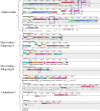Genetic and phenotypic diversity in Burkholderia: contributions by prophage and phage-like elements
- PMID: 20667135
- PMCID: PMC2920897
- DOI: 10.1186/1471-2180-10-202
Genetic and phenotypic diversity in Burkholderia: contributions by prophage and phage-like elements
Abstract
Background: Burkholderia species exhibit enormous phenotypic diversity, ranging from the nonpathogenic, soil- and water-inhabiting Burkholderia thailandensis to the virulent, host-adapted mammalian pathogen B. mallei. Genomic diversity is evident within Burkholderia species as well. Individual isolates of Burkholderia pseudomallei and B. thailandensis, for example, carry a variety of strain-specific genomic islands (GIs), including putative pathogenicity and metabolic islands, prophage-like islands, and prophages. These GIs may provide some strains with a competitive advantage in the environment and/or in the host relative to other strains.
Results: Here we present the results of analysis of 37 prophages, putative prophages, and prophage-like elements from six different Burkholderia species. Five of these were spontaneously induced to form bacteriophage particles from B. pseudomallei and B. thailandensis strains and were isolated and fully sequenced; 24 were computationally predicted in sequenced Burkholderia genomes; and eight are previously characterized prophages or prophage-like elements. The results reveal numerous differences in both genome structure and gene content among elements derived from different species as well as from strains within species, due in part to the incorporation of additional DNA, or 'morons' into the prophage genomes. Implications for pathogenicity are also discussed. Lastly, RNAseq analysis of gene expression showed that many of the genes in varphi1026b that appear to contribute to phage and lysogen fitness were expressed independently of the phage structural and replication genes.
Conclusions: This study provides the first estimate of the relative contribution of prophages to the vast phenotypic diversity found among the Burkholderiae.
Figures




Similar articles
-
Genomic diversity of Burkholderia pseudomallei clinical isolates: subtractive hybridization reveals a Burkholderia mallei-specific prophage in B. pseudomallei 1026b.J Bacteriol. 2004 Jun;186(12):3938-50. doi: 10.1128/JB.186.12.3938-3950.2004. J Bacteriol. 2004. PMID: 15175308 Free PMC article.
-
A Novel Inducible Prophage from Burkholderia Vietnamiensis G4 is Widely Distributed across the Species and Has Lytic Activity against Pathogenic Burkholderia.Viruses. 2020 May 31;12(6):601. doi: 10.3390/v12060601. Viruses. 2020. PMID: 32486377 Free PMC article.
-
Host population structure and species resolution reveal prophage transmission dynamics.mBio. 2024 Oct 16;15(10):e0237724. doi: 10.1128/mbio.02377-24. Epub 2024 Sep 24. mBio. 2024. PMID: 39315801 Free PMC article.
-
Diverse Antiphage Defenses Are Widespread Among Prophages and Mobile Genetic Elements.Annu Rev Virol. 2024 Sep;11(1):343-362. doi: 10.1146/annurev-virology-100422-125123. Epub 2024 Aug 30. Annu Rev Virol. 2024. PMID: 38950439 Review.
-
The role of prophage in plant-pathogenic bacteria.Annu Rev Phytopathol. 2013;51:429-51. doi: 10.1146/annurev-phyto-081211-173010. Epub 2013 May 24. Annu Rev Phytopathol. 2013. PMID: 23725471 Review.
Cited by
-
Analyses of the Distribution Patterns of Burkholderia pseudomallei and Associated Phages in Soil Samples in Thailand Suggest That Phage Presence Reduces the Frequency of Bacterial Isolation.PLoS Negl Trop Dis. 2016 Sep 26;10(9):e0005005. doi: 10.1371/journal.pntd.0005005. eCollection 2016 Sep. PLoS Negl Trop Dis. 2016. PMID: 27668750 Free PMC article.
-
Identification and characterization of ϕH111-1: A novel myovirus with broad activity against clinical isolates of Burkholderia cenocepacia.Bacteriophage. 2013 Oct 1;3(4):e26649. doi: 10.4161/bact.26649. Bacteriophage. 2013. PMID: 24265978 Free PMC article.
-
Dose-dependant acute or subacute disease caused by Burkholderia pseudomallei strain NCTC 13392 in a BALB/c aerosol model of infection.J Appl Microbiol. 2019 Oct;127(4):1224-1235. doi: 10.1111/jam.14396. Epub 2019 Aug 9. J Appl Microbiol. 2019. PMID: 31330088 Free PMC article.
-
The Burkholderia thailandensis Phages ΦE058 and ΦE067 Represent Distinct Prototypes of a New Subgroup of Temperate Burkholderia Myoviruses.Front Microbiol. 2020 May 27;11:1120. doi: 10.3389/fmicb.2020.01120. eCollection 2020. Front Microbiol. 2020. PMID: 32528458 Free PMC article.
-
Temperature dependent bacteriophages of a tropical bacterial pathogen.Front Microbiol. 2014 Nov 14;5:599. doi: 10.3389/fmicb.2014.00599. eCollection 2014. Front Microbiol. 2014. PMID: 25452746 Free PMC article.
References
-
- Vietri N, DeShazer D. In: Medical Aspects of Biological Warfare. Dembek Z, editor. Washington, DC: Dept of the Army, Office of the Surgeon General, Borden Institute; 2007. Melioidosis; pp. 225–230.
-
- Holden MT, Titball RW, Peacock SJ, Cerdeno-Tarraga AM, Atkins T, Crossman LC, Pitt T, Churcher C, Mungall K, Bentley SD. Genomic plasticity of the causative agent of melioidosis, Burkholderia pseudomallei. Proc Natl Acad Sci USA. 2004;101(39):14240–14245. doi: 10.1073/pnas.0403302101. - DOI - PMC - PubMed
Publication types
MeSH terms
Grants and funding
LinkOut - more resources
Full Text Sources
Molecular Biology Databases

